On this page
Introduction
Starting from the Back
Prodigious Number of Airfields
Object Lessons
Adopted Successful Tactics
To Sum Up
|
| | |
Earlier this summer George Metcalfe and Alan Jacobs (pilot and crew respectively) entered Euroglide 2004, a 2000km gliding race starting and ending in Eindhoven in the Netherlands and en route reaching close to the four corners of Germany. George, who flies his ASW-28 from Lasham, started gliding in 1976, has some 4350 hours and has flown extensively in UK competitions and been on expeditions to France, Spain and Austria. This is his account of the race. The photos are by Alan.
Unlike a standard gliding competition, when a different task is flown each day from the same airfield, during Euroglide the competitors are on the same task every day but flying from a number of airfields.
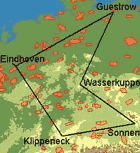 Euroglide 2004 task area Euroglide 2004 task area
Everyone starts from Eindhoven, but after that itís the pilotís choice how far he goes, where he lands and where he next takes-off. The ultimate aim is to complete the course and return to Eindhoven via the predefined turning points in the shortest time. Some make it back sooner than others (the differences counted in hours and in days) and some donít at all.
Each team has an allowance of distance which can be travelled by road (or by air for motorgliders and turbos) so that they can be sure to get to a launch site, or to a limited extent can make tactical moves to position best for the weather. There were 18 glider and 20 motorglider teams.
go to top
|
| | |
Euroglide started with a briefing the evening before the first contest day. Everything was very relaxed and friendly but as the briefing progressed it gradually dawned on me that I was inadequately prepared. Unlike a normal competition where the organisers brief you every day on the things you need to know, particularly weather and airspace, I suddenly realised that I had to do it all myself. I had acquired all the right maps (eight different 1:500 000s to cover the task area), but I hadnít even started to draw the route and find out about the airspace and airfields.
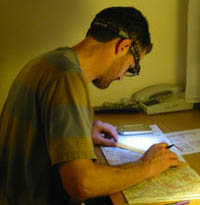 Pored over the maps till midnight. Pored over the maps till midnight.
I must admit I felt very daunted by the prospect. Everyone else went off to the welcome party while I returned to the hotel to pore over the maps. I didnít finish till after midnight, but by then I felt much better about it. The problem looks more manageable when broken into chunks than when you see the whole task on one page!
I was on the first row of the grid and launched eager to get going - no held start line in this comp. Unfortunately, I was back on the ground 15 minutes later. Even more unfortunately I was not back on the airfield. Never before have I landed out in a field before the grid has even finished launching! But in this competition, while I couldnít say it didnít matter, at least I could just go back and start again.
So, at 1400, two and a quarter hours after my first launch, I took off from Eindhoven again. This time it was 3.5m/s to cloudbase and I was on my way, with the sky all to myself. Objective Klippeneck.
I never realised how much high ground there is in Germany, and how much relief. It makes for interesting scenery and flying. There are also some big holes in the ground. Iíve never seen an open cast mine on the scale of those I passed that afternoon. And a little later on, the Mosel valley offered another dramatic scene - dramatic winding scar with deep-sided valleys completely covered in vines. It was in stark contrast to the lush woodlands, grass and cereal crops of the high plateau it divided.
There had been cumulus clouds, but two thirds of the way there it began to go blue. I managed to stay high for a while, but crossing the Rhine into French airspace I sank on to the hills on the south-east side, near Baden-Baden. I began to get nervous that I would land in the Rhine valley. I could see hazy air encroaching from the south-west and I really didnít want to still be here tomorrow morning. But the hills were friendly. Weak lift at first, then as I gradually worked my way up the slopes and spines the lift got stronger till I was in a position to reach the highest ridges where a small Cu gave me 1.5m/s to 2000m.
The calculator now said I could reach Klippeneck, 40km away, with 100m to spare. But calculators are always optimistic. I trickled across the plain. There were still isolated small Cu high up, so I told myself there must be something there lower down too. But it didnít really seem like it until at 300m just preparing to land at Rotweill airfield, I suddenly spotted a soaring bird. I drifted as I climbed, till I reached a knoll rising from the plateau 2 or 3km away. There I gained the 200m I needed for a comfortable arrival at Klippeneck. It was eight oíclock.
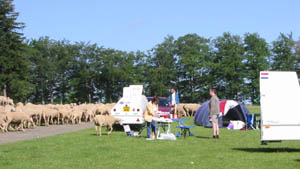 A flock of sheep at Klippeneck keeping the A flock of sheep at Klippeneck keeping the
grass cropped (and fertilised).
What a wonderful place. Acres and acres of wide open space amongst tall trees on the top of a sunlit plateau. A flock of sheep moved back and forth keeping the grass cropped (and fertilised). A perfect gliding spot. There were 15 other Euroglide teams there. We grouped together to park gliders and set up for the night, then went down to the village where someone had arranged with a local Gasthof to seat 20-30 Eurogliders for supper.
My crew was still 150kms away. Not only had he done one complete retrieve already but was now part way through a 600km drive to catch up with me. All the crews had arrived by about 2200 and a high time was had by all. Alan and I put our tents up just before midnight. Other teams had camper vans or slept in their cars and trailers. One even had a car and caravan to follow the car and glider around - impressive.
The next day was very relaxed - until briefing from the local chief pilot. Then it was a hive of activity with motorgliders taking off in one direction while the rest of us towed to the other end for a winch launch. The sky looked good and I went straight off the wire into 2m/s up to nearly 1800m. I should say that the airfield was at 900m, but nevertheless it looked as though we should have started an hour earlier.
We were going to Sonnen and then on towards Wasserkuppe. "Itís only a 500km" someone said. Actually itís about 700km, but probably better that I didnít know that till after the flight.
This was another good day. Mostly 2m/s climbs to around 200m, but a few stronger ones to greater heights. And, two enormous streets. One from the end of the Munich zone all the way to Passau (about 10km from the Sonnen turn) albeit quite a long way south of track, and another from about 10km from the turn for about 100km to the north-west. Trace analysis shows that I did a 49km glide in to the turn at an average speed of 150km/h and a glide ratio of 213. On the way out 54km at 126km/h (25-30km/h headwind by then) and a glide ratio of minus 1460 (ie slightly uphill!).
From there on it was climb and glide and with the wind breaking up the thermals it began to feel like hard work, but progress was still good at around 90km/h. I still thought I might get to Wasserkuppe, but all of a sudden someone switched the power of - 2.5m/s, then 2, then 1, and it was downhill all the way into Bamberg Airport.
Two people appeared immediately to help me move the glider off the runway, the air traffic controller arrived minutes later, having heard my radio call on his handheld at home. Also, thereís a webcam on the control tower, and another club member arrived having seen us on the Internet! It wasnít long before a tow pilot was arranged for the next morning with another one on standby in case it didnít get soarable till after midday.
My crew had already reached the Wasserkuppe by the time I called him, and had driven past Bamberg on the way. So he had 100km backtrack. His first question on arrival was "Why did they put the airfield in the middle of the town?". I hadnít really noticed, but yes, I suppose it did have town pretty well all around. But it had the advantage of a petrol station, pizzeria and supermarket close by.
In the morning it was very warm, but very overcast. However, eventually Cu began to form underneath, and it was time to go. There were only weak thermals, but no wind so I was able to make progress.
go to top
|
| | |
I had much more time to look at the ground this day because a) it was closer than normal and b) the climbs all took longer than normal. Just how many airfields are there in Germany? Every small town appeared to have at least one, and often there was another gliding site between there and the next one. In one place there was a matched pair of gliding clubs 2.7km apart. One sloped to the north and the other to the south. Do they move from one to the other depending on the wind?
After 80km the overcast killed off all signs of lift and I turned back to one of the pair of gliding sites I just mentioned. Iím sure they canít take-off uphill and almost sure they canít land downhill. There were five or six trailers parked outside, mostly Open Class, a substantial clubhouse and three small hangars, all cleverly adjoining one another. I found myself wondering how the finances work, especially when thereís another airfield so close.
Alan was not far away, and we were soon on the road to Wasserkuppe, stopping on the way at an idyllic restaurant terrace for beers.
So, to summarise so far: 430km flight, then 600km, then 80km, landing at respectively the most desirable ridge top gliding site you could imagine, a town airfield with no rules and procedures and club members who turn out specially, and a peaceful little club on the side of a hill. Ending up with beers in the late afternoon sunshine watching the kites soaring. What more could you ask for?
Well next day it all seemed to change.
It was 22km in a straight line to the Wasserkuppe, but a lot more by road! We arrived to find a number of others, some who had been there since yesterday. We had a good walk around, watched the paragliders, and marvelled at the undulating terrain that is still regarded as part of the airfield. We also marvelled at the shops and kiosks selling everything from Wasserkuppe gliding teddy bears to expensive jewellery. This is not only a place for gliding, parascending, hang gliding and aeromodelling, but also for skiing, rodelbahning (a toboggan run), walking place as well as being a general tourist trap. Not really my cup of tea, and must be a nightmare from the airfield safety point of view.
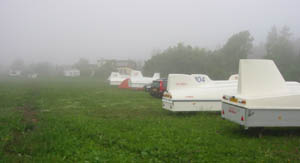 Classic summer gliding weather! Classic summer gliding weather!
This photo was taken at the Wasserkuppe.
Next day the wind was very strong from the west, showers and thunderstorms forecast, with the possibility of stabilising later on. Late in the afternoon the weather looked OK locally, but the wind was 90įs to track at 50km/h and it looked like a small weather slot. I decided not to fly. Three others launched and one came back. I later heard that one of those who left said that he regretted his decision.
The following day was similar after heavy rain during the night. At a detailed briefing from the flying school staff, an area of excellent conditions was forecast to the north (west of our track but well worth the detour).
By 1100, several of the Eurogliders were in the launch queue. Half an hour later I launched into a 3kt thermal, climbed straight to 5000asl and flew towards the next clouds on track. There was already a major cu-nim developing to the west (upwind of track), and showers in all directions. The clouds got lower along track with lightning from the cu-nim. I quickly rationalised that it was not a good idea to continue, and despite a little voice saying to me "You never know until youíve tried", I landed back at the Wasserkuppe.
One of the features of competition flying of any sort is that you discover there are things you donít know, and there are decisions you make which are proved to have been wrong...
Later that evening, I learned that the five pilots who got away from the Wasserkuppe that morning all flew 500km. Absolutely astonishing, and I felt totally depressed. The same little voice reminded me: "You never know until youíve tried".
The forecast for the next few days was dreadful. A deep low in the north-east of Germany - right where the last turning point was. It was going to be a long time until we could hope to round it - it was 400km away.
go to top
|
| | |
Get going early.
It can be better than it looks.
Try harder to understand the forecast and briefing, even if it is in a language you donít understand - the good conditions were forecast. (However, I must say that I did remember that when I decided to turn back - I have to accept that my decision, made for all good reasons, was wrong.)
Take every opportunity to fly, however unlikely looking.
The next morning it was sheeting with rain. The fantastic German gliding weather system showed that it was the same over the whole country. In retrospect, I realised I didnít know if this was an actual or a forecast. But I believed it anyway, and Alan and I went off to visit one of the two most impressive medieval fortresses in Germany (or so the guide book said).
Driving back, we suddenly realised that the sky was drying out dramatically. Combined with an SMS message from another competitor about his flight, I began to feel I had made a dreadful mistake.
However, when we got back to the Wasserkuppe we found that only two Eurogliders had left and even they had only repositioned to an airfield where you didnít have to take-off 20kt downwind (or uphill into curl-over) and the cloudbase would be higher (because the airfield was lower).
The next day looked a bit more promising. Cloudbase was only just over 300m above the site and thermals were not strong, but the wind was blowing in the right direction, so I set off. I found it difficult to predict where the thermals were, but made reasonable progress until nearly landing about 45km out.
Iím sure you all know the feeling: taking the weakest of climbs, hoping you will be able to stay in range of your field while the wind drags you away from it and over a large area of unlandable terrain. Trace analysis shows I climbed from 730m to 963m 14 minutes later and 7km further downwind. Why didnít I go and get something better? Well, the sky locally did not look good, my confidence was at an all time low, but conditions appeared to be better along track and I was desperate not to land.
Conditions were much better for a while after that, although not as strong as they looked. There were streets, but across track and too widely spaced for comfort (20-25km). After a while I found myself crossing one of those too wide gaps when, about half way across, I realised that nothing on the other side looked remotely attractive. I decided to stop for whatever I could find. What I found was weak and broken but it eventually gave me 400m at around 0.5m/s.
The cross-track streets were now developing into showers - joined up in rows, but with occasional gaps. It took a long time to work my way to a position where I felt I had enough height to skirt round the upwind side of a shower and glide slowly across the gap to some growing Cu near to a shower cell in the next street. The Cu worked well and I was soon at cloudbase, skirting around to the downwind side this time and hoping not to meet too much rain because I now had a marginal glide in to Guestrow - our next turning point and (given the state of the sky now) my intended landing place.
go to top
|
| | |
I was lucky as I actually gained height in the rain and I then glid serenely down hill for 40km to arrive at Guestrow. A satisfying flight, though much of it had been in weak lift and rather precarious, because at last Iíd overcome the difficulties and adopted successful tactics with the marching procession of showers which guarded the last 100km into Guestrow.
Arriving at Guestrow was an experience in itself. A car came out to tow me off the airstrip and into the compound enclosing the hangars and accommodation. There were also perhaps 20 tents housing all those who were participating in a three-week soaring and training camp run by the Guestrow and the Rostock clubs.
As I arrived in the compound people appeared, one by one, from within or behind buildings or tents. Almost without exception, they were carrying bottles of beer from which they took frequent draughts. I began to wonder what I had dropped in on and was slightly apprehensive about whether I would fit in to the culture or community!
However, I was received by friendly but slightly reserved pilots who were all very interested in what I was doing there, where I normally flew, what the weather had been like, where I had come from that day and all seemed delighted to be able to have their photos taken sitting in my ASW-28.
This was the first airfield in what was East Germany that I had arrived at and it was clear where the history and culture of the operation lay. They lacked nothing in flying and launching equipment, nor airfield facilities generally, having five or six two-seaters (Bocians and Puchaz), three or four Pirat single-seaters, a Junior, Std Jantar, a Tost twin drum winch, a Wilga tug and a Falke motorglider.
Over the next 36 hours, I learned a lot about them and their history. They were just like other glider pilots with aspirations, limitations (mainly in climate and cost, but certainly not in enthusiasm) lots of humour and, very strongly in this case, a relaxed but quietly disciplined and effective co-operative aimed at getting lots of flying for lots of people.
They gave us every assistance with weather information, launches, with accommodation in their bunkhouse, even, on our first evening, with a guided tour of the town, ending by delivering us to a restaurant where we enjoyed the best meal of the trip at a very reasonable cost. They had evidently been having an uproarious time, as evidenced by the photos they showed me (I should add that, apart from the beer bottle, the other thing that each person seemed to have was a digital camera).
I think I was in a mindset that everything would be different in the East. It wasnít, but before I had realised that, I had encountered a roll or toilet paper on which each sheet was numbered in ball point pen. I admit that it took me a little while to realise that this was all part of the humour!
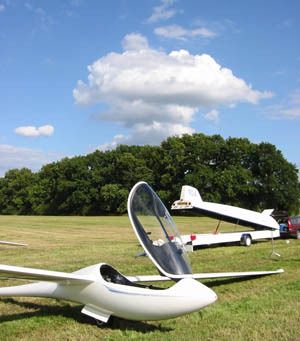 After another 50km I missed one After another 50km I missed one
and ended up in a field.
The next morning the weather was fine but showers were forecast again. By then there were three Euroglide gliders there, the last arriving by road during the night having landed out part way from the Wasserkuppe. We launched a couple of times, soared a little bit but didnít mange to break away. It was no hardship to stay another night.
The next day looked a bit better, though the wind was strong and from the wrong direction. However, we all got away, in my case struggling under a relatively low cloudbase in weak thermals for the first 50kms. Then things got better, but were still difficult because the sky was cycling rapidly and it was difficult to ensure you arrived at a cloud when it was working, and the spaces between were too wide to allow mistakes. After another 50km I missed one and ended up in a field.
We decided to visit the gliding site at Neu Gulze, only 9km away from the field, to see if they could launch me the following day. We arrived to find two club members installing a new kitchen. The members had created almost everything from the hangar, clubroom, shower, toilets, water system, right to the gliders, many of which had been rebuilt from insurance write-offs. A splendid example of self help and wise deployment of scarce finances.
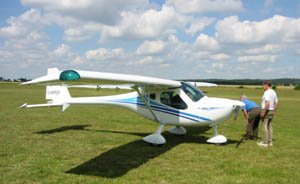 The ULM tug at Neu Gulze. The ULM tug at Neu Gulze.
We found there was a ULM with a towing hook... perhaps Gunther (the owner) would be able to launch me? But he was in the air and no-one knew when heíd be back. A unilateral decision was taken by Alan to set up camp in the belief that it would all work out right - the members were so welcoming, and the place so peaceful. Gunther was pleased to help. Heíd be here to launch me at 1200 - he told us it would not be any good before that. He already knew exactly where I had landed and all about Euroglide - news travelled fast in that rural community.
The members took us to the local restaurant and couldnít have been friendlier. And, next morning, they were still there - apparently having changed their plans to ensure we got off OK. So we enjoyed a leisurely breakfast with them in the sunshine outside their clubroom. We provided the bread and cheese, they the eggs and coffee.
It was almost windless, and by 1100 there were nicely formed and spaced flat Cu. Surely Gunther must have looked out of the window, but then surely also he had a living to earn. We saw a two-seater go over - a Duo Discus or a DG500 - one of our competitors who had found somewhere with an earlier launch capability. My glider was on the runway threshold, with 50kg of waterballast - I wanted to carry more but felt I had to give the 90hp ULM tug half a chance!
Gunther arrived exactly when he said he would and we were off, having first pushed the glider 50 metres further back! The tow was a bit slower than weíre used to these days, both in the ground acceleration and in the climb, but no drama or even fleeting concern once we got moving.
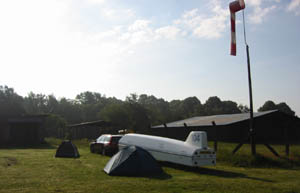 Early morning at Neu Gulze. Early morning at Neu Gulze.
The thermals were weak and when I eventually reached cloudbase, it was only about 800m. The ground locally was low lying and quite damp - maybe things would be better once we got further away. The cloudbase did go up to about 1100m, and from time to time I found a quite good thermal - 2m/s was what I was looking for, but the characteristic of the day was that I could rarely find a good one when I needed one, and when I did find one it seemed to be by chance.
Gradually the wind increased from practically nothing to about 30km/h. At least for once it was in almost exactly the right direction. Then some high cloud appeared and drifted left to right across my track. It became more and more difficult to find decent thermals as the heating was reduced and the wind broke up the thermals. Every time I struggled to a reasonable height, my attempts to stay there came to nothing and I inevitably ended up desperately searching around low down for anything climbable. At least this must have been partly because Iíd accumulated an enormous number of bugs. This was a really good advert for bug-wipers (which I didnít have).
After a while I could see off to the left of track some thinning and breaks in the high cloud, though if there were any thermals, they must be "blue". Straight ahead under deepening overcast, there were still some Cu - but Iíd been disappointed by the Cu many times already that day. What should I do? The decision was made for me by some airspace!
For the first time during the whole of Euroglide, my request to transit a controlled area was declined and as I had not called up until I was very close to the boundary. This meant an almost 90į deviation. I was forced to go for the blue.
I then had a succession of low scrapes where I struggled away from circuit height to around 700m, but all the time drifting in the right direction. It was not long afterwards that I landed, 325km from take-off and about 115 track kilometres from Eindhoven. Iíd really rather have liked to have been 15km further on... just one more thermal or maybe even just one stretched glide. But woodlands and a small town made the prospect appear more foolhardy then brave and I managed to stop myself trying!
The weather forecast was not great for the remaining days, but there would perhaps be a slot the next day. So we went to Terlet (about 35km away) even though it would be downwind of the last TP and Eindhoven, because it was the only place we were confident of getting a launch.
Next morning at Terlet, neither the weather information nor the site management was particularly encouraging, and the sky didnít look too good either. The synoptics appeared to suggest that now there would be a better chance if we went 100km south and tried to drift in towards home on the wind. So off we went to Venlo.
At Venlo, they normally do operate on a Thursday, but not that Thursday! Theyíd seen the weather forecast and cancelled. We couldnít launch, but there was never a time when it looked as though youíd want to, so it didnít matter.
So that was that. Having enough displacement credits to allow us to complete the journey back to Eindhoven by road, we had to call it a day. We checked in, transferred the logger files to the organisers, and set off later that afternoon towards Calais under, wouldnít you know it. A beautiful cumulus filled sky.
go to top
|
| | |
Looking back over what Iíve written, there is a lot about problems and challenges. This is what gliding is to me - a perpetual search for something better. No flight is good all the way through, and the good climbs and the good streets last all too little. I wish I could be like some others who seem to remember only the 8kt thermals! I wouldnít want you to think the whole event was difficult or a trial. On the contrary, it was fun, interesting, varied, challenging, and thoroughly to be recommended.
Who was the winner? Well we don't know yet. It takes time to sort this out and the nature of Euroglide is fun rather than competition.
George Metcalfe
go to top
|
|